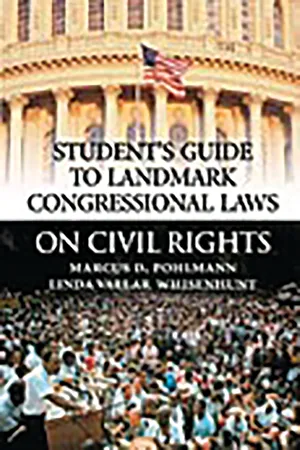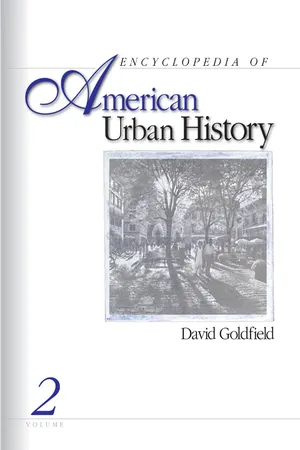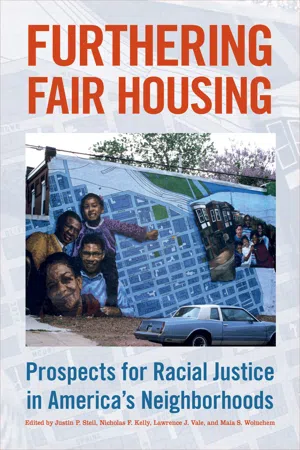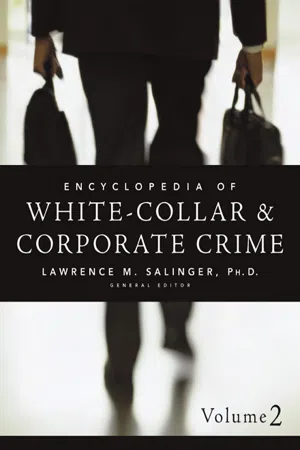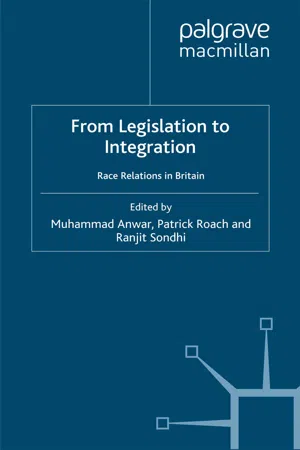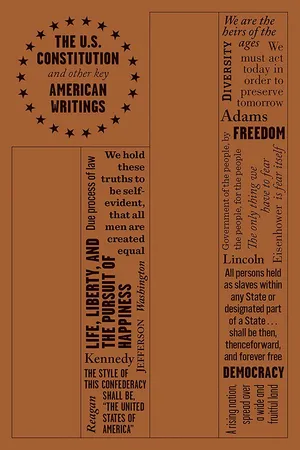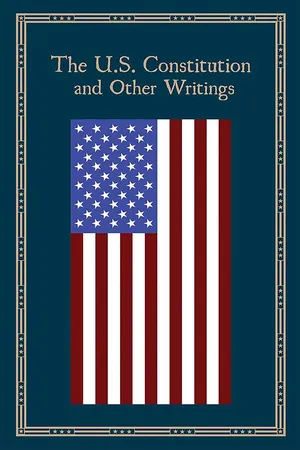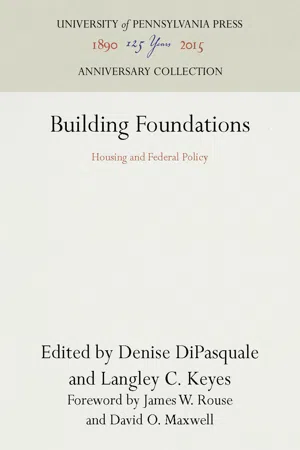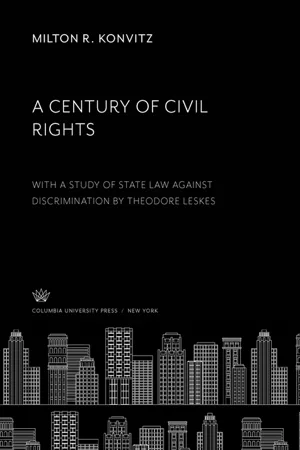Politics & International Relations
Civil Rights Act of 1968
The Civil Rights Act of 1968, also known as the Fair Housing Act, aimed to address housing discrimination by prohibiting the refusal to sell or rent a dwelling to any person based on their race, color, religion, or national origin. It also made it a federal crime to "by force or by threat of force, injure, intimidate, or interfere with anyone" exercising their fair housing rights.
Written by Perlego with AI-assistance
Related key terms
1 of 5
9 Key excerpts on "Civil Rights Act of 1968"
- Marcus D. Pohlmann, Linda Vallar Whisenhunt(Authors)
- 2002(Publication Date)
- Greenwood(Publisher)
John Ashbrook (Rep., Ohio), for example, decried "the Reichstag-type rubberstamp process" and concluded, "The whole concept of freedom and private property are at stake here." 14 Titles eight and nine of the 1968 Civil Rights Act, also known as either the Fair Housing Act or the Open Housing Act, prohibited discrimination on the basis of race, sex, national origin, color, re- ligion, handicap, and familial status in the sale, rental, financing, or advertising of housing, with a few minor exceptions for owner- occupied homes sold or rented without a real estate agent. Violators faced significant penalties. The Department of Housing and Urban Development was given the authority to initiate complaints. Mean- while, the Department of Justice was granted litigation authority. Yet, the burden of proof remained on the complainant, and that person had to seek local remedies first. The act also included a punitive antirioting provision and barred discrimination in jury se- lection. 15 FAIR HOUSING ACT 265 In June 1968, the United States Supreme Court broadened legal coverage, ruling that the Civil Rights Act of 1866 already banned racial discrimination in the sale and rental of all residential hous- ing. 16 Earlier, the court had struck down racial zoning and refused to allow judicial enforcement of restrictive covenants—legal agree- ments that required homeowners to sell on the basis of race. 17 In handing down these decisions, the nation's highest court was at- tempting to eliminate the racial discrimination that "herds men into ghettos and makes their ability to buy property turn on the color of their skin." 18 The pronouncements were sweeping, but the enforcement mech- anisms were weak. Individuals had to file suit themselves and then had the burden of proof, even though such discrimination is often subtle and hard to pinpoint. Fair housing groups attempted to help, but little actually changed as a result of this original law.- eBook - PDF
- David Goldfield, David R. Goldfield(Authors)
- 2006(Publication Date)
- SAGE Publications, Inc(Publisher)
President John F. Kennedy signed Executive Order 11063 on November 20, 1962, which was the first attempt to prevent discrimination at the national level. The order only applied to federally assisted housing that came under contract after that date, so its scope was limited, but it was an important first step. Under pressure from the Civil Rights Movement (such as the 1963 march on Washington), Congress supported the fight against discrimination by passing Title VI of the Civil Rights Act of 1964. The act outlawed discrimination in employment and public accommodations, and although not a fair hous-ing law, the act barred discrimination in all federally funded activities, including housing. The assassination of Martin Luther King in April 1968 generated momentum in Congress to support civil rights, which helped with the passage of the 1968 Civil Rights Act. Title VIII of that act, the Fair Housing Act, prohibited discrimination in the sale or rental of all housing except for housing sold or rented without the services of a broker and that did not include four or more units. Private individuals who had suffered discrimination could sue, and the U.S. Attorney General was empowered to act if there was a pattern of discrimination. Soon after the passage of the Fair Housing Act, the U.S. Supreme Court greatly expanded the impact of the fair housing legislation. In the case of Jones v. Mayer, in which the Alfred H. Mayer Company refused to sell a home in suburban St. Louis to an African American buyer who then sued to force the sale, the U.S. Supreme Court found in favor of the plaintiff based on the Civil Rights Act of 1866 rather than the traditional equal protection clause of the Fourteenth Amendment. This meant that federal legis-lation applied to transactions between private indi-viduals, not just discrimination on the part of the government. - eBook - PDF
Furthering Fair Housing
Prospects for Racial Justice in America's Neighborhoods
- Justin P. Steil, Nicholas F. Kelly, Lawrence J. Vale, Maia S. Woluchem, Justin P. Steil, Nicholas F. Kelly, Lawrence J. Vale, Maia S. Woluchem(Authors)
- 2021(Publication Date)
- Temple University Press(Publisher)
Having held hearings and debated the bill extensively in previous sessions, Congress now chiefly struggled over proce-dural issues. In February and March, the Democratic leadership maneuvered to obtain additional votes to cut off a filibuster by Southern conservatives. The cloture effort gained almost enough votes when Senate minority leader Dirksen threw his support in return for weakening the bill’s enforcement provision and reducing its coverage. In March, the release of the dramatic Kerner Commission report shook loose the remaining needed votes. 54 After passing the Senate, the bill went to the House, where it appeared it might expire in the Rules Committee. But the assassination of King on April 4, and the ensuing violence in the streets of Washington, galvanized The Origins of the Fair Housing Act of 1968 / 63 the House, which passed the Senate’s version of the bill by a wide margin. On April 11, Johnson signed the Civil Rights Act of 1968 into law, including Title VIII. The Provision That Inspired the Affirmatively Furthering Fair Housing Rule Consistent with its history, the Fair Housing Act aimed to stop discrimina-tion, first in the selling and renting of residences and second in the corollary activities of real estate brokering and lending. It covered anyone involved in private housing transactions, with the exceptions of owner-occupants who owned buildings with four or fewer dwellings or who sold their single-family houses without professional help. As in earlier proposed legislation, the Fair Housing Act prohibited discrimination in any form of real estate financ-ing. Beside prohibiting real estate steering and redlining by lenders, the law included a new provision to ban the practice of blockbusting. The 1968 law placed HUD in charge of enforcement, but the agency could only act in re-sponse to individuals’ complaints and use persuasion to change discrimina-tory behaviors or, as a last resort, refer the cases to the Justice Department. - Lawrence M. Salinger(Author)
- 2004(Publication Date)
- SAGE Publications, Inc(Publisher)
Fair Housing Act CONTAINED WITHIN the Civil Rights Act of 1968, the Fair Housing Act (Title VIII) bans poten-tial discrimination in the real estate market. Most housing types are covered by the Fair Housing Act, except for certain exemptions by the act, which in-clude buildings occupied by the owner with fewer than four units, single-family homes rented or sold without the assistance of a realtor, and housing ad-ministered or operated by private clubs. Enforce-ment of the Fair Housing Act is the responsibility of the U.S. Department of Housing and Urban De-velopment (HUD). The Fair Housing Act bans a number of dis-criminatory real estate actions based on race, na-tional origin, religion, sex, familial status, or disabilities. No one may refuse to rent or sell hous-ing, refuse to negotiate, take property off the mar-ket, deny the availability of a property, establish different guideline or fees for the sale or rental, pro-vide different services or facilities, force owners to sell or rent, or deny listing of a sale or rental based on discriminatory criteria. When dealing with mortgages, no one may deny a mortgage loan, re-fuse to provide loan details, set different mortgage terms, or appraise a property differently. Lastly, the Fair Housing Act prohibits one from threatening or intimidating a person who is exercising his or her fair housing rights, or from advertising or making statements which portray a preference in a real es-tate transaction based on discriminatory criteria. If someone has a disability, she receives addi-tional protection of her fair housing rights. A land-lord may not refuse any reasonable modifications to the property if it allows a potential resident to use the housing, and landlords must make reasonable changes to housing policies or practices which make F 307 The Fair Housing Act regulated against discrimination based on family status or disability, among other criteria.- eBook - PDF
From Legislation to Integration?
Race Relations in Britain
- M. Anwar, P. Roach, R. Sondhi, M. Anwar, P. Roach, R. Sondhi(Authors)
- 1999(Publication Date)
- Palgrave Macmillan(Publisher)
NOTES I. This discussion does not extend to include an analysis of the political, legislative and historical background of these laws which would high- light the fundamental provisions and compromises inherent in each. 2. Stephen Small, Racialized Barriers: The Black Experience in the United States and England in the 1980s (New York: Routledge, 1994). 3. Muhammed Anwar, 'What Impact has Race Relations Legislation Made on British Race Relations?', paper presented at the Conference 'From Legislation to Integration?' held at the University of Warwick, Coventry in September 1996. 4. US Commission on Civil Rights (1994), the Fair Housing Amendments Act of 1988: the Enforcement Report (September) (Washington, DC: GPO, 1995); Funding Federal Civil Rights Enforcement (June) (Washington, DC: US Commission on Civil Rights, 1996); Federal Title VI Enforcement to Ensure Nondiscrimination in Federally Assisted Programs (June) (Washington, DC: US Commission on Civil Rights). 5. See note I above. 6. 'It is hereby declared to the policy of the President that there shall be equality of treatment and opportunity of all persons in the armed ser- vices without regard to race, color, religion or national origin. This policy shall be put into effect as rapidly as possible, having due regard to Lessonsfrom the US Civil Rights Experience 155 the time required to effectuate any necessary changes without impair- ing efficiency or morale' (Federal Register, 28July 1948, p. 4313). 7. In 1987, Congress passed the Civil Rights Restoration Act which declared that Title VI covers the entire operation of the federally funded recipient and not solely the particular programme receiving federal funds. This was enacted to offset a Supreme Court decision in the Grove City College v. Bell case. There are several other federal statutes which also prohibit discrimination in any programme receiving federal financial assistance, including Section 109 covering HUD's community development programs. - Founding Fathers(Author)
- 2015(Publication Date)
- Canterbury Classics(Publisher)
THE CIVIL RIGHTS ACT (1964) __________ In June 1963, President John F. Kennedy proposed that the United States adopt a sweeping civil rights law that would prohibit segregation in all public places and of all public facilities, would prohibit restrictions to voting rights, and would prohibit employment discrimination based on race, color, sex, religion, or national origin. After Kennedy’s assassination in 1963, President Lyndon B. Johnson continued to fight for the legislation. He faced much opposition in Congress, including a Senate filibuster, but the Civil Rights Act finally became law on July 2, 1964. A n act To enforce the constitutional right to vote, to confer jurisdiction upon the district courts of the United States to provide injunctive relief against discrimination in public accommodations, to authorize the Attorney General to institute suits to protect constitutional rights in public facilities and public education, to extend the Commission on Civil Rights, to prevent discrimination in federally assisted programs, to establish a Commission on Equal Employment Opportunity, and for other purposes. Be it enacted by the Senate and House of Representatives of the United States of America in Congress assembled, That this Act may be cited as the “Civil Rights Act of 1964”. T ITLE I V OTING R IGHTS S EC. 101. Section 2004 of the Revised Statutes (42 U.S.C. 1971), as amended by section 131 of the Civil Rights Act of 1957 (71 Stat. 637), and as further amended by section 601 of the Civil Rights Act of 1960 (74 Stat- eBook - ePub
- (Author)
- 2017(Publication Date)
- Canterbury Classics(Publisher)
THE CI VIL RIGHTS AC T (1964) In June 1963, President John F. Kennedy proposed that the United States adopt a sweeping civil rights law that would prohibit segregation in all public places and of all public facilities, would prohibit restrictions to voting rights, and would prohibit employment discrimination based on race, color, sex, religion, or national origin. After Kennedy’s assassination in 1963, President Lyndon B. Johnson continued to fight for the legislation. He faced much opposition in Congress, including a Senate filibuster, but the Civil Rights Act finally became law on July 2, 1964. A n act To enforce the constitutional right to vote, to confer jurisdiction upon the district courts of the United States to provide injunctive relief against discrimination in public accommodations, to authorize the Attorney General to institute suits to protect constitutional rights in public facilities and public education, to extend the Commission on Civil Rights, to prevent discrimination in federally assisted programs, to establish a Commission on Equal Employment Opportunity, and for other purposes. Be it enacted by the Senate and House of Representatives of the United States of America in Congress assembled, That this Act may be cited as the “Civil Rights Act of 1964”. T ITLE I V OTING R IGHTS S EC. 101. Section 2004 of the Revised Statutes (42 U.S.C. 1971), as amended by section 131 of the Civil Rights Act of 1957 (71 Stat. 637), and as further amended by section 601 of the Civil Rights Act of 1960 (74 Stat - eBook - PDF
Building Foundations
Housing and Federal Policy
- Denise DiPasquale, Langley C. Keyes, Denise DiPasquale, Langley C. Keyes(Authors)
- 2017(Publication Date)
Chapter 5 Federal Fair Housing Policy: The Great Misapprehension George C. Galster Martin Luther King fell to an assassin's bullet on April 4, 1968. One week later an omnibus civil rights bill passed Congress, after languishing for years in committees. Title VIII of this bill prohibited discrimination against those who would rent or purchase homes on the basis of race, sex, creed, national-ity, or religion. Federal fair housing law figuratively was born out of King's casket. The passage of federal fair housing statutes brought us a step closer to the goal of equal housing opportunities for all citizens. With twenty years of hindsight it appears to be but a baby step, however, in light of two salient facts. First, illegal acts of housing discrimination continue to be perpetrated at an alarming rate. Recent audits that have utilized interracial pairs of testers have found, on average, that black homebuyers face at least a one-in-five chance of being discriminated against each time they confront a housing agent. 1 The comparable figures for black and Hispanic apartment seekers are one-in-two and one-in-three, respectively. Second, a high level of racial resi-dential segregation persists. On average, 79 percent of black households would need to move from their 1980 location in order to achieve complete integration of our larger metropolitan areas (where most blacks live). The comparable percentages are 48 and 43 for Hispanics and Asians, respec-tively. 2 Recent studies have found that the segregation of blacks within our large metropolitan areas has hardly changed since 1970. The isolation of His-panics from Anglos has increased in areas with significant gains in Hispanic population. 3 Why has federal fair housing policy apparently had such limited effi-cacy? I propose that federal fair housing policy has suffered from crucial mis-apprehensions over the ends of policy, the means of achieving these ends, and the process of implementing these means. - eBook - PDF
A Century of Civil Rights
With a Study of State Law Against Discrimination by Theodore Leskes
- Milton R. Konvitz(Author)
- 2019(Publication Date)
- Columbia University Press(Publisher)
Chapter 9 FAIR HOUSING PRACTICES Residential housing, despite its importance and its impact upon discrimination in other areas of community life, such as schools, recreational facilities, health and welfare service, and even em-ployment opportunities, appears to be the last of the major areas of discrimination that the states have been willing to attack. Thus, although several states had laws on their books before 1949 prohibiting discrimination in public housing projects, no really effective remedy was available to the person victimized by such discrimination until Connecticut extended the jurisdiction of its Civil Rights Commission in 1949 to include complaints involving public housing. It will be recalled that in that year Connecticut amended its public accommodations statute to broaden the duties of its Civil Rights Commission. The same amendment added the words all public housing projects to the list of place of public accommoda-tion in which discrimination was prohibited. 1 This created a new civil right under state law and provided an administrative rem-edy. The civil right was the right of all persons within the juris-diction of the state to full and equal consideration for public housing projects without discrimination based on race, creed, or color. The administrative remedy was the time-tested procedure established several years earlier as part of the FEP Law. In 1953 the legislature of Connecticut again amended its public accommodations statute. This time the specific listing of places 1 Public Act of July 13, 1949. Fair Housing Practices 237 included within the term place of public accommodation was dropped and general language substituted. The term was defined as any establishment, including, but not limited to, public housing projects and all other forms of publicly assisted housing, which caters or offers its services or facilities or goods to the general public (italics added).
Index pages curate the most relevant extracts from our library of academic textbooks. They’ve been created using an in-house natural language model (NLM), each adding context and meaning to key research topics.
